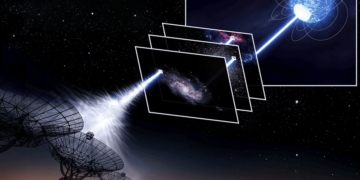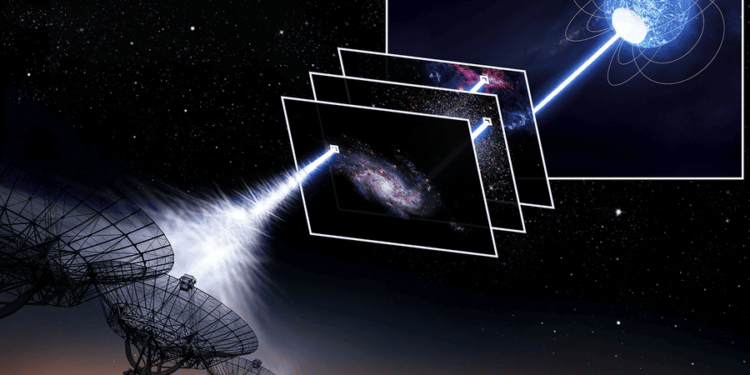The universe is filled with mysteries, but few are as perplexing as Fast Radio Bursts (FRBs). These fleeting, intense blasts of radio energy have baffled astronomers since their discovery in 2007. Now, a groundbreaking study using the Westerbork Synthesis Radio Telescope (WSRT) has shed light on the origins of these phenomena.
What Are Fast Radio Bursts (FRBs)?
Fast Radio Bursts are ultra-bright, millisecond-long flashes of radio waves that originate from deep space. Despite their brevity, these signals pack an immense amount of energy—equivalent to what the Sun emits in an entire month. Some FRBs are one-time events, while others repeat, deepening the mystery of their origins.
Astronomers initially speculated various potential sources, from colliding black holes to alien civilizations. However, the characteristics of FRBs—such as their intensity, duration, and distance—have increasingly pointed toward extreme astrophysical phenomena. Neutron stars, remnants of massive stars that collapsed under their gravity, emerged as the leading candidates.
The Breakthrough Discovery
A team led by the Netherlands Institute for Radio Astronomy (ASTRON) made a significant leap in understanding FRBs by observing 24 new bursts with the WSRT. This powerful observatory uses aperture synthesis to generate highly detailed radio images of the sky, making it an invaluable tool for studying elusive phenomena like FRBs.
These observations were enhanced by the Apertif Radio Transient System (ARTS), an experimental supercomputer designed to analyze radio signals from the sky. ARTS autonomously identified radio bursts that were exceptionally bright, brief, and distant. This innovative approach allowed researchers to study FRBs in unprecedented detail.
According to Dr. Inés Pastor-Marazuela, the study’s lead author, the shape and behavior of these FRBs closely resemble emissions from young neutron stars. These findings strongly suggest that young, magnetized neutron stars are the primary sources of these bursts.
The Connection to Young Neutron Stars
Neutron stars are incredibly dense objects left behind after massive stars explode in supernovae. Some neutron stars are highly magnetized, creating intense magnetic fields that can produce powerful radio emissions. The WSRT observations revealed that the detected FRBs exhibited characteristics consistent with these magnetized neutron stars.
The study found that the FRBs were not only incredibly bright but also altered as they traveled through space for billions of years. This distortion aligns with the properties of young neutron stars, which are more active and energetic than older ones. Such stars could generate the immense energy required to produce FRBs.
A Cosmic Puzzle: Brighter Than Ever
One of the most surprising discoveries was an FRB that was a billion times brighter than any previously observed neutron star emission. This unprecedented brightness challenges existing astrophysical models and raises new questions about the mechanisms powering these bursts.
How can a young neutron star generate such an intense burst of energy? The answer may lie in the interaction between the star’s magnetic field and its surrounding environment. Alternatively, this extraordinary brightness could hint at previously unknown physical processes occurring in the extreme conditions around neutron stars.
Dr. Joeri van Leeuwen, a senior researcher at ASTRON, expressed excitement about the discovery, stating, “The universe has made the puzzle a billion times harder, but that’s what makes it fascinating.”
Advanced Tools Driving Discovery
The technological advancements behind this discovery are as remarkable as the findings themselves. The WSRT’s ability to generate detailed radio images, combined with ARTS’ computational power, enabled researchers to identify and analyze FRBs with unparalleled precision.
ARTS uses machine learning algorithms to sift through vast amounts of data, autonomously identifying signals that match the profile of an FRB. This process has revolutionized the study of transient astrophysical phenomena, allowing researchers to focus on the most promising candidates.
These tools are paving the way for future discoveries, including more precise localization of FRBs and a deeper understanding of their origins.
Why This Discovery Matters
Understanding FRBs is not just an academic exercise; it has profound implications for astrophysics and cosmology. These bursts serve as cosmic beacons, providing valuable information about the universe’s structure and evolution.
For instance, the way FRBs travel through space can reveal details about the distribution of matter in the cosmos. By studying these signals, scientists can map the large-scale structure of the universe and gain insights into phenomena like dark matter and dark energy.
Additionally, linking FRBs to young neutron stars helps refine our understanding of these exotic objects and their role in the universe.
Unanswered Questions and Future Directions
While this discovery is a significant step forward, many questions remain. Why are some FRBs one-off events while others repeat? What determines the incredible brightness of certain bursts? And how do the magnetic fields of young neutron stars influence their emissions?
Future research will focus on addressing these questions. Upcoming observatories, such as the Square Kilometre Array (SKA), will provide even greater sensitivity and resolution, enabling scientists to study FRBs in more detail. Collaborative efforts between international research teams will also play a crucial role in advancing our understanding.
Conclusion
The discovery of 24 new FRBs and their connection to young neutron stars marks a milestone in the study of these enigmatic signals. By combining advanced technology with innovative research methods, scientists have unraveled some of the mystery surrounding FRBs while uncovering new puzzles to solve.
Reference:
Comprehensive analysis of the Apertif fast radio burst sample



















